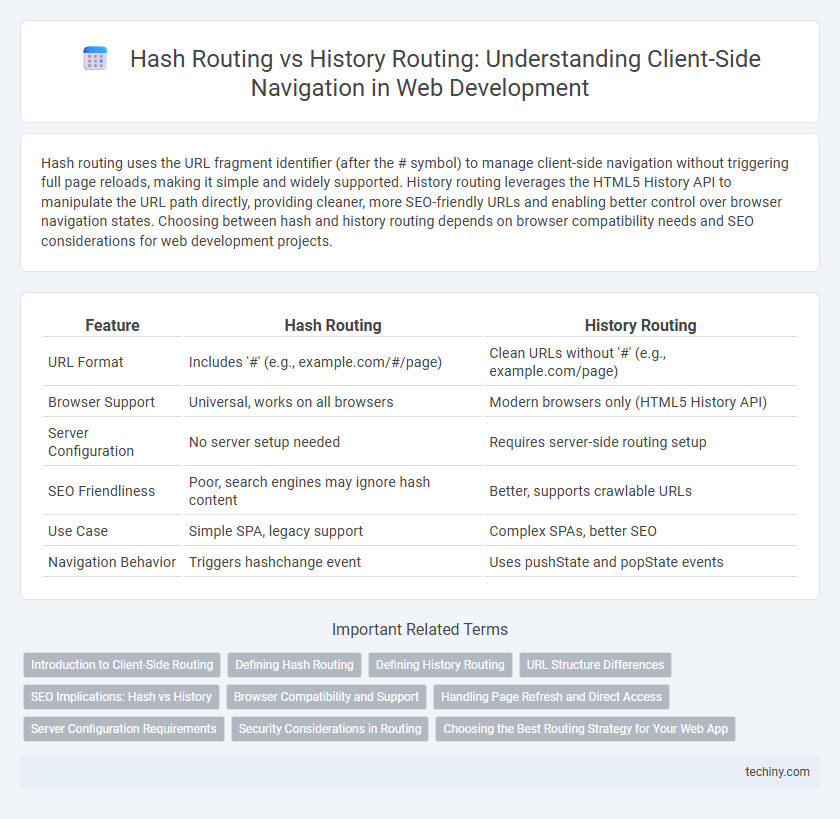Hash routing uses the URL fragment identifier (after the # symbol) to manage client-side navigation without triggering full page reloads, making it simple and widely supported. History routing leverages the HTML5 History API to manipulate the URL path directly, providing cleaner, more SEO-friendly URLs and enabling better control over browser navigation states. Choosing between hash and history routing depends on browser compatibility needs and SEO considerations for web development projects.
Table of Comparison
| Feature | Hash Routing | History Routing |
|---|---|---|
| URL Format | Includes '#' (e.g., example.com/#/page) | Clean URLs without '#' (e.g., example.com/page) |
| Browser Support | Universal, works on all browsers | Modern browsers only (HTML5 History API) |
| Server Configuration | No server setup needed | Requires server-side routing setup |
| SEO Friendliness | Poor, search engines may ignore hash content | Better, supports crawlable URLs |
| Use Case | Simple SPA, legacy support | Complex SPAs, better SEO |
| Navigation Behavior | Triggers hashchange event | Uses pushState and popState events |
Introduction to Client-Side Routing
Client-side routing enables single-page applications (SPAs) to dynamically update content without full page reloads, enhancing performance and user experience. Hash routing leverages the URL fragment identifier (after #) to manage navigation states, ensuring compatibility with older browsers by relying on the browser's default behavior. History API routing uses the HTML5 History API (pushState and popState) to create clean URLs and seamless navigation, offering greater control over browser history and SEO optimization.
Defining Hash Routing
Hash routing uses the URL fragment identifier, the portion after the "#" symbol, to manage client-side navigation without triggering full page reloads. This method leverages the browser's native handling of hash changes to update the view dynamically, making it ideal for single-page applications (SPAs). Hash routing ensures compatibility with older browsers and avoids server-side configuration for route handling.
Defining History Routing
History routing leverages the HTML5 History API to manipulate the browser's session history, enabling clean URLs without the hash (#) symbol. This technique uses `pushState` and `replaceState` methods to update the URL and manage navigation state without triggering full page reloads. History routing improves user experience by allowing traditional URL structures and better integration with server-side rendering and SEO.
URL Structure Differences
Hash routing uses the URL fragment identifier after the "#" symbol, enabling client-side navigation without server requests, resulting in URLs like example.com/#/page. History routing leverages the HTML5 History API to manipulate the URL path directly, producing clean URLs such as example.com/page without the hash symbol. These structural differences impact SEO, server configuration, and user experience depending on routing choice.
SEO Implications: Hash vs History
History API routing offers cleaner URLs that are better indexed by search engines, enhancing SEO performance compared to hash-based routing. Hash routing uses URL fragments that are often ignored or poorly interpreted by crawlers, limiting visibility in search results. Implementing server-side configurations with history routing ensures proper URL handling and improves the site's overall search ranking potential.
Browser Compatibility and Support
Hash routing leverages the URL fragment identifier after the '#' symbol, ensuring seamless compatibility across all major browsers, including legacy versions like Internet Explorer, as it doesn't require server-side configuration. History routing uses the HTML5 History API to manipulate the browser's session history and URLs without a page reload, providing cleaner URLs but necessitating server support for route handling, which may lead to issues in older browsers lacking full History API support. Choosing between hash and history routing depends on the target audience's browser capabilities and the server's ability to manage dynamic routing requests effectively.
Handling Page Refresh and Direct Access
Hash routing uses URL fragments (e.g., #/page) to manage navigation without triggering a full page reload, ensuring consistent behavior during page refresh and direct access by relying on client-side rendering. History routing leverages the HTML5 History API, enabling clean URLs (e.g., /page) that require server configuration to handle direct access and page refresh correctly by serving the same entry point regardless of the requested path. Proper server setup with history routing prevents 404 errors on refresh or direct URL access by redirecting all routes to the single-page application's main HTML file.
Server Configuration Requirements
Hash routing operates entirely on the client side and requires no special server configuration since the URL fragment after the hash symbol (#) is not sent to the server. History routing leverages the HTML5 History API and demands server-side configuration to redirect all route requests to the application's entry point, preventing 404 errors on page reload or direct URL access. Properly configured servers serve the index.html for all matched routes, enabling seamless navigation and deep linking in history-based routing.
Security Considerations in Routing
Hash routing exposes client-side routes after the "#" symbol, limiting server-side access and reducing risks of direct URL manipulation or unauthorized data exposure. History routing relies on the HTML5 History API, which modifies the URL path and requires proper server configuration to prevent unauthorized access or URL tampering. Ensuring secure routing involves implementing robust server-side checks, HTTPS protocols, and validating user permissions regardless of the chosen routing method.
Choosing the Best Routing Strategy for Your Web App
Choosing the best routing strategy for your web app hinges on understanding the differences between hash-based and history-based routing. Hash routing uses URL fragments after the # symbol, making it easier to implement without server configuration but less SEO-friendly, while history routing leverages the HTML5 History API to create cleaner URLs and better SEO outcomes but requires server support for handling route requests. Developers should consider factors like SEO needs, server setup, and user experience when deciding between hash and history routing for optimal web app performance.
hash vs history (routing) Infographic

 techiny.com
techiny.com